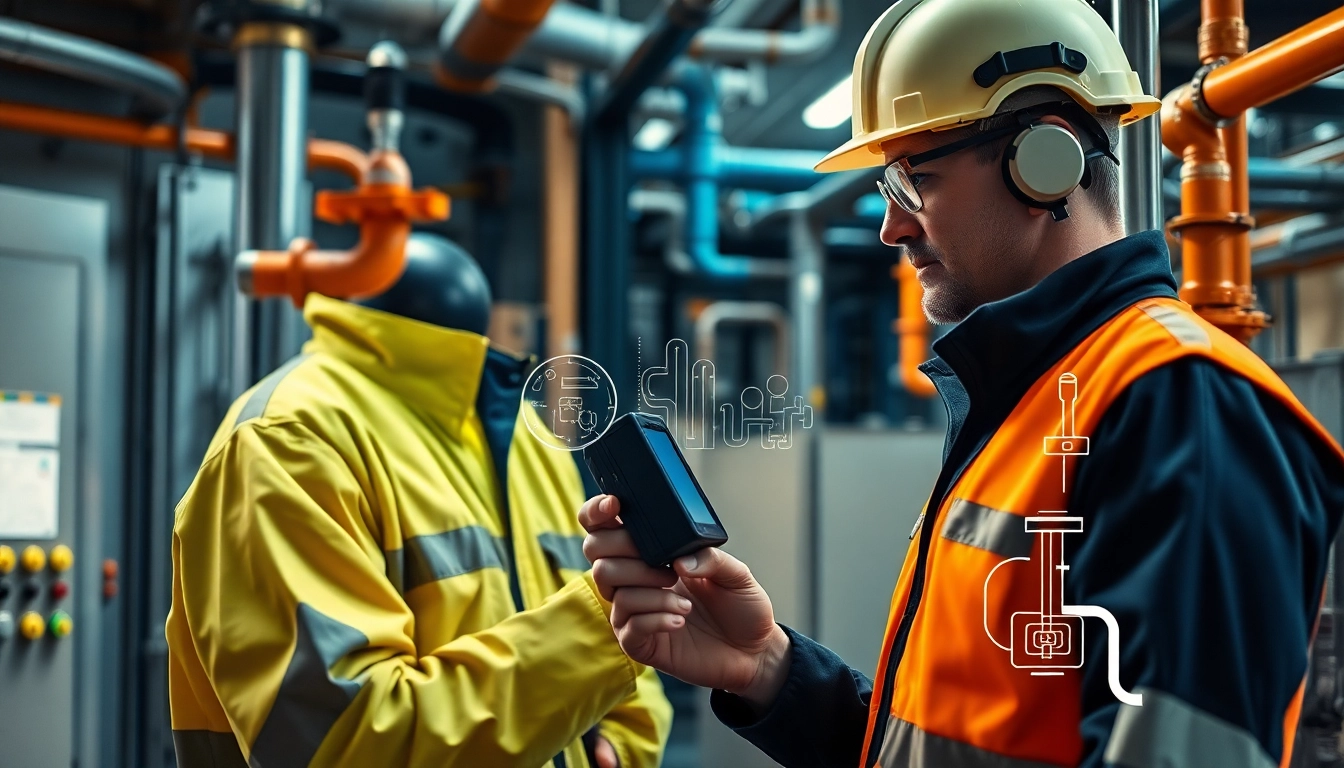Understanding Tracer Gas Leak Detection
What is Tracer Gas Leak Detection?
Tracer gas leak detection is a sophisticated technique employed to identify leaks in various systems or structures by utilizing tracer gases that can easily penetrate even the tiniest of openings. This method leverages the unique properties of selected gases, typically helium or hydrogen, to trace leaks with high sensitivity and accuracy. The test involves introducing a non-toxic tracer gas into the system or area being tested, which then escapes through any leaks present. Specialized equipment detects the escaping gas, allowing operators to pinpoint the location and severity of the leak effectively.
Unlike traditional methods, which often rely on visual inspections or water-based approaches, tracer gas detection offers a nondestructive, efficient, and quick solution suitable for a wide range of applications. In many instances, it is considered the gold standard for leak detection due to its reliability and precision, making it a preferred choice for engineers and technicians across various industries. For more on this innovative technology, visit Tracer Gas Leak Detection.
Importance of Accurate Leak Detection
Accurate leak detection is vital across numerous sectors, including manufacturing, HVAC, automotive, and even healthcare. The implications of undetected leaks can be severe, potentially leading to substantial financial losses, safety hazards, and environmental damage. For instance, in industrial settings, gas leaks can pose immediate risks to personnel and equipment. The cost associated with equipment failure due to leaks can accumulate quickly, culminating in expensive repairs and downtime.
Additionally, for sectors bound by regulatory compliance, accurate leak detection fosters adherence to safety standards, minimizing the risk of penalties for non-compliance. Effective leak detection serves not only as a preventative measure but also as a critical aspect of overall operational efficiency, ensuring systems run smoothly and sustainably.
Common Applications of Tracer Gas Leak Detection
The versatility of tracer gas leak detection allows it to serve a plethora of applications:
- HVAC Systems: Ensuring that heating, ventilation, and air conditioning systems operate without leaks is crucial for efficiency and indoor air quality.
- Pipelines: In oil, gas, and water utility industries, tracer gas is employed to maintain pipeline integrity and ensure timely repairs.
- Automotive Industry: Used in the testing of components like fuel tanks and exhaust systems, tracer gas helps verify the efficiency and safety of vehicles.
- Building Inspections: Tracer gas is instrumental in assessing the integrity of buildings, identifying leaks that may lead to energy loss or moisture ingress.
- Laboratories: In scientific environments, maintaining the integrity of systems is paramount, making tracer gas an essential tool for leak detection.
Technologies Behind Tracer Gas Leak Detection
Types of Tracer Gases Used
Various gases can be used as tracers, each with specific properties that make them suitable for different applications:
- Helium: High sensitivity due to its small molecular size and non-condensable nature, making it ideal for vacuum systems.
- Hydrogen: Light and non-toxic, often mixed with nitrogen for safety reasons, preferred in multiple leak detection scenarios.
- R134A: Used primarily in refrigeration systems, this greenhouse gas detection helps ensure eco-compliance.
The choice of tracer gas often depends on the specific requirements of the leak testing scenario, including safety considerations, environmental impact, and the expected leak size.
Advanced Detection Equipment
Advanced detection equipment has significantly enhanced the efficiency and accuracy of tracer gas leak detection. Some widely used tools include:
- Mass Spectrometers: Highly sensitive devices that measure the concentration of gases, providing real-time results for small leaks.
- Electronic Sniffers: Portable devices designed to detect the presence of tracer gases in the atmosphere surrounding tested systems.
- Optical Sensors: Utilizing laser technology, these sensors can detect the distinct signatures of tracer gases efficiently.
The integration of these advanced technologies into leak detection processes has led to improved responsiveness and reduced troubleshooting time for maintenance teams.
How Sensors Work in Tracer Gas Leak Detection
Sensors designed for tracer gas detection operate based on the principle of gas concentration measurement. Typically, the process involves:
- Introducing the tracer gas into the system under test.
- Monitoring the area with sensitive detectors which respond to the presence of the gas.
- Identifying and quantifying leaks based on the concentration levels of the tracer gas detected in the environment.
By converting gas concentrations into measurable data, these sensors provide engineers and technicians with critical insights into leak locations and sizes, facilitating precise and expedited repairs.
Conducting Tracer Gas Leak Detection
Step-by-Step Process
The process of conducting tracer gas leak detection typically involves the following steps:
- Preparation: Ensure the testing environment is suitable and safe. This includes conducting preliminary checks for other potential leak sources.
- Introduction of Tracer Gas: Inject the chosen tracer gas into the system or area under inspection at a controlled pressure.
- Monitoring: Utilize detection equipment to monitor areas surrounding the system for any indication of gas escape.
- Data Analysis: Analyze data collected from sensors to determine the presence, size, and location of any leaks.
- Reporting: Document findings, providing a comprehensive report that informs maintenance and repair strategies.
Safety Protocols and Best Practices
Safety is paramount when conducting tracer gas leak detection. Here are some best practices:
- Personal Protective Equipment (PPE): Always wear appropriate PPE, such as gloves and goggles, when conducting leak detection.
- Ventilation: Ensure proper ventilation in the area being tested to mitigate any potential gas buildup.
- Equipment Calibration: Regularly calibrate detection equipment to maintain accuracy and reliability.
- Training: Provide comprehensive training for personnel involved in tracer gas leak detection to ensure adherence to safety protocols.
Common Challenges in Implementation
While tracer gas leak detection is highly effective, some challenges may arise:
- Complex System Designs: Intricate designs may make it difficult to uniformly distribute tracer gases for effective testing.
- Environmental Conditions: Weather factors such as wind or humidity can impact detection accuracy.
- Interference from Other Gases: The presence of other gases in the environment can lead to false readings.
Addressing these challenges requires careful planning and consideration of environmental conditions, equipment choice, and experienced personnel.
Benefits of Using Tracer Gas Leak Detection
Cost Savings and Efficiency
Employing tracer gas leak detection can lead to significant cost savings by reducing the time and labor required for leak identification and repair. The specialized equipment can quickly locate leaks, enabling faster interventions, which not only mitigates damages but also preserves operational efficiency. Moreover, early detection of leaks can avert larger problems down the line, minimizing the overall maintenance costs and improving resource allocation.
Environmental Impact and Safety
Utilizing tracer gas detection enhances environmental safety by preventing the release of potentially harmful gases into the environment. Given that many sectors are facing increasing pressure to comply with environmental regulations, employing this technology positions organizations favorably from a compliance standpoint, ultimately supporting sustainable practices.
Regulatory Compliance Advantages
Adhering to leak detection regulations is critical in many industries. Utilizing sophisticated tracer gas detection methods not only fulfills regulatory obligations but also signals to stakeholders a commitment to quality and safety. Efficient leak detection processes can enhance company reputation while reducing the risk of legal complications or fines associated with environmental violations.
Future Trends in Tracer Gas Leak Detection
Innovations on the Horizon
The landscape of tracer gas leak detection is continually evolving. Emerging technologies are set to redefine how industries approach leak detection. Innovations such as enhanced sensor technology, collection of real-time data analytics, and automated reporting mechanisms promise to improve accuracy and make leak detection more accessible. Moreover, there is a growing emphasis on integrating artificial intelligence and machine learning algorithms to predict potential failure points within systems.
Integration with Smart Technologies
As industries worldwide embrace the Internet of Things (IoT), the future of tracer gas leak detection looks promising. Smart sensor technologies that can communicate in real time with centralized monitoring systems offer the potential for immediate action in response to detected leaks. This integration can significantly reduce response times and streamline leak detection processes, positioning organizations to proactively manage risks.
Predictive Maintenance and Leak Prevention
Advancements in predictive maintenance techniques are poised to change the dynamics of leak detection. By leveraging big data analytics and predictive modelling, organizations can identify weak points within systems before they lead to leaks, facilitating preventative interventions. This proactive approach will not only enhance operational efficiency but also reduce the overall costs associated with maintenance and repairs.




